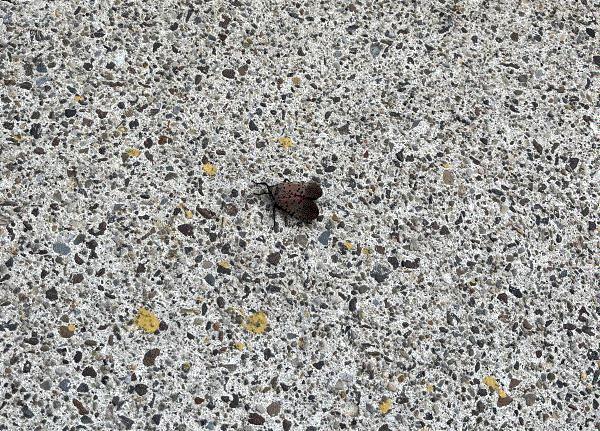When JC Meets SLF
There were no fireworks, no epiphany, no rush of excitement. There was just, “Hello, there!”
I was at Cultivate’25 last week and saw two spotted lanternflies (SLF) on the sidewalk outside of Hilton Columbus Downtown. One had gone belly-up (literally). The other one (pictured below) was seeing light at the end of the tunnel. Not sure what happened to them. I bet no one saw them, other than me.

I’m not surprised to see SLF in Columbus. SLF has been in Ohio since 2020 and in Columbus since 2023. Quarantine was declared for several counties in 2021, but has since been expanded, most recently in May 2025. The total number of quarantined counties in Ohio stands at 18.

Reported distribution of SLF in Ohio. Actual infestation areas may only encompass a small portion of the highlighted areas. (Map credit: Ohio Department of Agriculture.)
The two SLF are perhaps the earliest adults to have shown up in the city. They’re the harbinger of things (or hordes) to come. Watch for more of them and kill, kill, kill! Go HERE for an egg hatch predictor from Pennsylvania State University and HERE for a life stage predictor from Cornell University.

Mums Under Heat
I returned to Charleston, South Carolina, from Columbus around 11:00 p.m. Eastern on Thursday. Not that I planned to get home late because I had something exciting to do in Columbus—unscheduled delays were the cause. Meh, I’m used to it. In fact, I’m surprised when all legs of a trip don’t hit some kind of trouble.
Anyway, I stepped out of the airport and the hot, humid air hit me like a wet blanket. I couldn’t breathe for a few seconds. Ah, South Carolina Low Country in the summer. I’m home.
We had 90-plus degree temperatures late in the afternoon and 90% to 100% humidity in the late evening and early morning last week. To call it oppressive is an understatement. I’m not feeling great, and my wife and her dog are definitely suffering. But we also need to spare a thought for the plants, especially those poor young mums in the field.
Heat isn’t great for growing mums outdoors. Think about it—having your roots in a black pot and media that can heat up to over 120F for hours on end is probably worse for your health than hopping over hot sand on a beach on your way to cool water. This is part of the reason why the root balls of heat-stressed mums aren’t grown evenly in the media. Often, roots are sparce on the south-facing side of the containers. The uneven root growth also leads to uneven canopy growth, at least based on my observations.
Delivering more water by putting the emitters on the south-facing side is a good way to alleviate some of the stress and help the roots recover. But remember that too much water isn’t always a good thing. In fact, heat stress combined with excessive moisture is a welcomed recipe for many soil-borne pathogens. The recipe is made even sweeter if the mums are constantly and aggressively liquid fed.
During the repeated heat/dry/wet cycle, salts (from fertilizer) can build up and open wounds in roots that serve as entries for pathogens such as Fusarium and Pythium. So instead of hoping that the fertilizer solution will cool down the plants, I’d irrigate with clean water during hot days or cycling between clean and fertilized water regardless of the temperature. That way, you can use clean water to cool down the roots and flush out some of the salt.
Heat isn’t great for the canopy, either. But cooling down the canopy seems a little easier, especially if you have a way to mist the leaves. Misting is great because the water will dry quickly (takes away heat as water evaporates) and you may not have an elevated risk of foliar diseases. (I hypothesize that misting may have the benefit of slowing down spider mite populations, which loves it hot and dry. No one let me test for this hypothesis, though ... not yet anyway.)

Mum Diseases
Managing environmental conditions (such as moisture, airflow and temperature) and growing practices (such as sanitation, irrigation and fertilization) are paramount to preventing disease development in mum production. Remember the “disease triangle”? You need a favorable environment, a susceptible host and a virulent pathogen to start a disease. Managing environmental and cultural issues can help deny some fuel to the outbreak.
When it’s hot and humid, or when rain is abundant, I watch for all sorts of diseases. The stressed and wounded roots and the hot, wet media mentioned above are ideal for Fusarium wilt and Pythium root rot. Rhizoctonia blight also pops up once in a while. The initial symptoms of these root and stem diseases is often wilt, which can lead folks to increase irrigation and exacerbate the problem. For Fusarium wilt, the symptom will progress to collapse of the canopy on only one side of the pot. I strongly recommend that you send in samples for diagnosis because management approaches to Fusarium and Pythium are very different.
Botrytis and bacterial leaf spots are the more common foliar diseases. Chrysanthemum White Rust is more common further north; in the South, I've never had the pleasure of seeing what this disease can do. Botrytis is more problematic when it’s cooler (65F to 75F-ish) and very humid. Bacterial leaf spots and blights are more common when it’s warmer (65F to 80F-ish) and during periods of rain. So watch the weather and prepare preventive fungicide treatments when the temperature and humidity conditions are favorable for these diseases.
As for what fungicides to use, whether biological or conventional, check out GrowerTalks’s 2025 Biosolutions Guide and Insecticide, Miticide & Fungicide Guide. Alternatively, call your favorite extension plant pathologist, or distributor or manufacturer reps. I also talked about managing bugs and diseases of mums in this newsletter in 2022. (A 2022 version may sound old, but you know what? Nothing new has really happened since then.)

Mum Pests
I mentioned spider mites on mums earlier because a nice man named Henry asked me how to control them when I saw him at Cultivate’25. Spider mites are just one of several pests that can ruin a mum crop. Today, I’ll review four of the most common pests I've seen during the growing phase. Go HERE for a discussion on controlling pests and diseases closer to the time of shipping.
Since Henry asked, I’ll start with twospotted spider mites. As I mentioned above, twospotted spider mites are worse when it’s hot and dry, so I often see serious infestation on drip-irrigated plants later in the season. Damage by twospotted spider mites includes stippling, leaf chlorosis, leaf drop and flower abortion. This damage is in many ways similar, so it can be confused with damage by thrips. You should find the critters and identify them properly because management tools for spider mites and thrips, whether chemical or biological, aren’t the same.
Aphids (several species of them) are common on garden and pot mums. Honeydew, sooty mold and shed skins all look quite nasty on mums. Early detection and treatment, and thorough spray coverage are key to controlling aphids effectively.
Caterpillars pop up once in a while. Beet armyworm is the most common species I’ve found, but I've also come across corn earworm and looper in the past. If you're missing chunks of leaves or flower petals, look deep in the canopy for caterpillars.
There are quite a number of biological control solutions for thrips, spider mites and aphids. I suggest choosing the right species, starting early and using frequently. Biological solutions for caterpillars is a bit more limited, but many folks have found success with spraying the entomopathogenic bacterium Bacillus thuringiensis when used regularly and against younger caterpillars. For other biosolutions, check out GrowerTalks’s 2025 Biosolutions Guide.
Many insecticides are also registered to control these pests. You can find what insecticides are registered to control which pests by studying the GrowerTalks’s Insecticide, Miticide & Fungicide Guide or the Bug Poster I put together. The back side of the Bug Poster also has several rotation programs. Again, you can always call your favorite people, whether they’re your fellow growers, extension entomologists or company reps. Or email me or read this newsletter from 2022.

Advanced Irrigation Management Course to Start in August
The Advanced Irrigation Management course, which is part of the University of Florida Greenhouse Training Online Program, will start on August 4. This is a brand-new course for the award-winning training program.
This course aims to train nursery, greenhouse and controlled environment agriculture staff who have some experience in production, technical and sales roles on how to match irrigation with crop needs—all for the goals of improving crop growth and sustainability.
The course will be taught by Dr. John Lea-Cox, Professor Emeritus at the University of Maryland and an international expert in water and nutrient management. Topics to be covered include irrigation system components, design criteria, hydraulics, controllers, audits and best irrigation management practices.

The course is in both English and Spanish. The duration of the course is four weeks, from August 4 to August 29. The lectures can be completed at your own pace, but the typical time commitment is about six hours per week. The cost of training is $285 per person. Go HERE to register for the course.

Native Plant Survey
Do you propagate, grow and/or sell native plants? If you do, please take five minutes from your busy day and fill out a short survey prepared by researchers at The Ohio State University. The goal of the survey is to gather, from you, the producers of native plants, what you think are important research and extension priorities in the realm of native plant propagation and production. Outcomes of the survey may help to improve production practices.
Your response will remain confidential and you can stop at any time during the survey for whatever reason you have (or no a reason at all). You won’t get a limited edition Labubu doll, nor a gift card (not even a cup of coffee). Instead, you’ll have the satisfaction of knowing that you’ve help shape future research and extension efforts in native plant production.
Did I sell the survey to you yet? Yes? Great! Go HERE to participate in the survey. The deadline for completing it is September 26, 2025. If you have any questions, email Garrett Owen at OSU.



See y'all later!

JC Chong
Technical Development Manager at SePRO
Adjunct Professor at Clemson University
This e-mail received by 27,847 subscribers like you!
If you're interested in advertising on PestTalks contact Kim Brown ASAP!